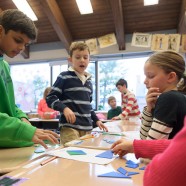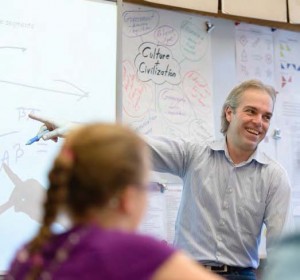
Milton’s fourth graders learn three core tenets of working with numbers: flexibility, efficiency and accuracy. In other words, their teacher Randy Schmidt says, finding the right answer is important, but it’s not quite enough.
“Students often come in with just the accuracy part,” Randy laughs, “and that leads to the other important work that we do.”
They begin the year reviewing addition and subtraction strategies, as Randy reexamines or introduces multiple strategies for each operation. “Being open to a new strategy when they already have one down is challenging for some students,” he says. He makes it clear that the technique they know works well, but that it might not be the best choice for every problem. Approaching a problem with this flexibility can be a struggle at first.
Flexible thinking in math means looking closely and figuring out what the numbers in the problem are actually telling you to do. Many students learn the traditional “stacking” algorithm early on, but if, for instance, you’re adding 157 and 99, it makes more sense to add 100 and then “adjust” by subtracting one. Learning this strategy of compensation is an “aha!” moment for many students. Once the students own the different strategies, deciding which one works best is up to them. They also start to make connections: When multiplying 27 times 35 they may use partial products, which is just another way to represent the traditional algorithm. They learn that while many strategies will work for any given problem, their job is to find the most efficient one.
 Moving on to multiplication, Randy relates calculations to real-life applications, using both open and closed arrays, and lots of hands-on projects. One popular unit is Muffles Truffles, about a candy maker with a ditzy assistant who makes lots of mistakes. Randy charges the students with cleaning up the mathematical messes.
Moving on to multiplication, Randy relates calculations to real-life applications, using both open and closed arrays, and lots of hands-on projects. One popular unit is Muffles Truffles, about a candy maker with a ditzy assistant who makes lots of mistakes. Randy charges the students with cleaning up the mathematical messes.
Always using accurate mathematical language—factors, products, multiples—students connect their multiplication strategies with division calculations; they learn to relate fractions with decimals, percentages and probability. They tackle two-
dimensional geometry—why is a square a square? Why is a square always a rhombus, but a rhombus isn’t always a square? Students experiment with tangrams, paying attention to symmetry and patterns. Randy, a visual learner himself, brings quilts from home and talks with students about transforming shapes through rotations, translations and reflections. The children then dive into three-dimensional geometry—interpreting silhouette views, drawing their own isometric views, and then building those three-dimensional structures.
Working in partnerships, fourth graders create colorful posters representing their work. To close a unit, the students go on a “gallery walk,” checking out their classmates’ creations. When they share feedback, Randy’s method is WWW.EBI—what went well and even better if. “We start with the positive, because something went well,” he says. “Then, instead of saying, ‘You did this wrong,’ we say, ‘It would be even better if…’”
The children realize quickly that they’re able to find shortcuts. “I want them to get to the shortcuts,” says Randy, “but I don’t present those right away. First, they need to understand why the shortcuts work.”
Equally important is helping students learn how to communicate their thinking. Saying, “I just know it,” doesn’t cut it, so in class they break things down into smaller components. They walk through problems step by step. Explaining your thought process is an important skill, which students practice through lots of partner and small-group work.
“One of the big risks for children is volunteering to share, even when they’re not quite sure of the answer,” says Randy. “We celebrate that. Getting the wrong answer is an example of courage in the classroom, and students need to feel comfortable taking risks. That’s how we learn.”
Randy is glad that in fourth grade math is one of the students’ favorite subjects. Many appreciate the finality of a definitively correct answer. In Randy’s classroom, however, they learn that they’re in charge, and need to be creative, when it comes to finding that answer.
“I want my students to understand the math behind the math, so that they are comfortable when they get into algebraic functions,” he says. “I hope students leave my class realizing that they’re not just calculators, but problem solvers.”
—Erin E. Berg



